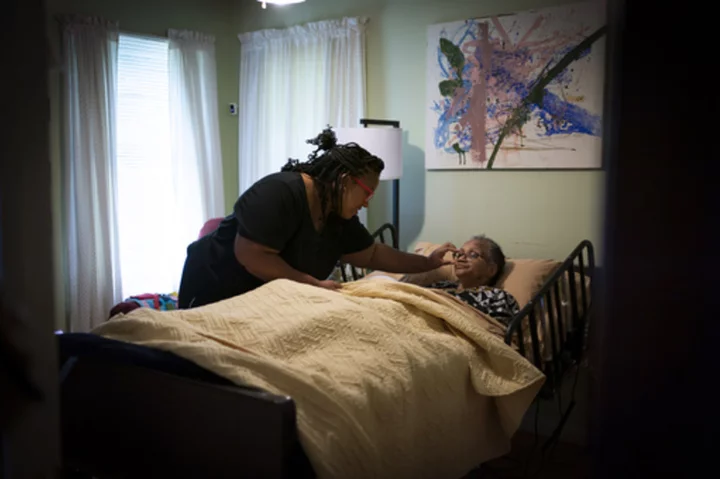FREDERICKSBURG, Va. (AP) — Constance Guthrie is not yet dead, but her daughter has begun to plan her funeral.
It will be, Jessica Guthrie says, in a Black-owned funeral home, with the songs of her ancestors. She envisions a celebration of her mother’s life, not a tragic recitation of her long decline.
As it should be. Constance has lived 74 years, many of them good, as a Black woman, a mother, educator and businesswoman.
But she will die of Alzheimer’s disease, a scourge of Black Americans that threatens to grow far worse in coming decades.
Black people are more likely to develop Alzheimer’s than white people in the United States. They are less likely to be correctly diagnosed, and their families often struggle to get treatment from a medical system filled with bias against them.
About 14% of Black people in America over the age of 65 have Alzheimer’s, compared with 10% of white people, according to the Centers for Disease Control and Prevention. The disparity is likely even more, because many Black people aren’t correctly diagnosed.
And by 2060, cases are expected to increase fourfold among Black Americans.
While some risk factors may differ by race, the large disparities among racial groups can’t be explained just by genetics.
The problems start much earlier in life. Health conditions like heart disease and diabetes are known risk factors. Both are more common among Black populations, because of where they live in relation to polluting industries, lack of healthy food choices, and other factors. Depression, high blood pressure, obesity and chronic stress can also raise the likelihood of developing Alzheimer’s. So can poverty.
Across the board, Black people don’t receive the same quality of health care throughout life as white people.
So they don’t get high quality treatment — or any treatment — for all those conditions that are risk factors. Then, at the end, they’re less likely to get medication to ease the symptoms of Alzheimer’s and dementia-related disorders.
And there’s the insidious impact of a life experiencing racism.
Racism is trauma that can lead to increased stress, which can in turn cause health problems like inflammation, which is a risk factor for cognitive decline, said Dr. Carl V. Hill, chief diversity, equity and inclusion officer of the Alzheimer’s Association.
“But because of this structural racism that creates poor access to health, medication, housing, those who experience racism and discrimination are not provided a pathway to lower their risk,” Hill said.
It is, he said, “a one-two punch.”
For Jessica, it has meant the final years of her mother’s life have been filled not with peace, but heartache and frustration, as she navigates doctors who don’t believe her when she says her mom is suffering. In the slow, plodding walk that is her mother’s final years, she has few health care partners.
“It has been pervasive across multiple doctors, emergency rooms and hospital doctors,” Jessica said. “Not being listened to, not believed, not given the full treatment.”
“To be a caregiver of someone living with Alzheimer’s is that you watch your loved one die every day. I’ve been grieving my mom for seven years.”
___
EDITOR’S NOTE: This story is part of an AP series examining the health disparities experienced by Black Americans across a lifetime.
___
The salon was called “Hair by Connie,” and for 18 years it was the place to go in Alexandria, Virginia, if you were a Black woman who wanted to look her best. Reigning over the shop was its owner, Constance Guthrie.
She traveled the world, attending hair shows. She opened her salon to fashion shows like the “Tall, Full and Sassy” event advertised in an old flyer she now keeps in a box of mementos. She donned dazzling, colorful and flamboyant outfits to match her larger-than-life personality.
In the 1990s, she made the difficult decision to move and close her beloved salon. She bought a home in Fredericksburg so her daughter could attend the best schools, and later became a paraprofessional in the local school district, which allowed her to have a schedule where she never missed oratorical contests or choir recitals.
She was always there for Jessica, who is her only child. They often stayed up into the wee hours of the night working on school projects together. Despite meager means, Jessica grew up surrounded by encouragement and love.
“My mother gave up everything to make sure that I had the greatest support, the greatest opportunities,” Jessica Guthrie recalled. “We were like two peas in a pod.”
Her mother’s hard work paid off. Jessica became a teacher and later moved to Dallas to build her own life and chase her dreams, where she was a successful chief program officer for an education service.
Then, seven years ago, Constance began her descent into dementia.
She started to forget simple things, like where her keys were. She lost her way coming home from work on a familiar route she traveled almost daily for 18 years. She got into a car accident.
The frequency of troubling incidents began to increase, worrying Jessica who was still hundreds of miles away in Texas.
They tried to use Post-it notes to remind Constance of daily tasks. Some of the colorful notes still line the walls of the family’s home.
For a woman who had grown accustomed to being so independent, it was hard for her to accept that she needed help.
“She spent so long trying to hide it,” Jessica said. “Like, ‘Oh, I’m good, I’m fine. I just forgot.’ But you could tell that a lot of her anxiety and stress was because she was trying to cover this up from other people.”
She began to wander around her neighborhood. Jessica and nearby loved ones tried to bolt the door to prevent her from wandering.
A neurologist confirmed she was suffering early cognitive decline and that it was likely Alzheimer’s.
She was just 66 when she was diagnosed.
Soon after, Jessica made the tough decision to pack up and leave Dallas behind to care for her mother full time. She recently began working remotely again after taking an extended leave of absence to care for her mother.
Constance never had diabetes nor high blood pressure — which are common risk factors. She was fairly active and healthy, and would often walk around her neighborhood. But in 2015, Constance suffered a transient ischaemic attack, or a “mini stroke,” which is a brief disruption in the blood supply to part of the brain.
Jessica believes the mini stroke could have been caused in part by the heavy stress her mother endured at her job, where she worked for 18 years as a special education paraprofessional.
She also questions the role genetics played in her mother’s diagnosis. Her mother’s aunts are all living with the disease. Her mother’s brother, who was a doctor, has started to experience cognitive decline. ___
Lost in her own mind, Constance can no longer testify to the difficulties she endured — as a mother, a Black entrepreneur running a business on her own.
But her daughter, Jessica, can attest to the struggles she’s had, as a Black caregiver, trying to ensure that her mother receives appropriate care.
In 2018, her mother started pointing at her stomach, repeatedly, trying to tell her daughter she was in pain. Jessica took her to her primary care physician, who is white and brushed the concerns aside.
“My mother couldn’t articulate that there was significant pain in the moment and the doctor of the practice basically said, ‘Oh, well, you know, sometimes they just come in and put on a show and it seems like she’s fine,’” Jessica said. “They asked, ‘Are you sure she’s in so much pain?’”
They sent her home without performing further diagnostic tests. But the pain persisted.
Jessica took her mother to the emergency room the next day and a Black male doctor ordered the necessary imaging. She needed emergency surgery to correct a painful, protruding hernia.
Then there was the time she took her mother to the emergency room for intense leg pain. She had arthritis in her knee but Jessica suspected something more serious.
The doctor told her she likely just needed rehab for her bad knee. Jessica advocated for more testing and it turned out Constance had a blood clot in her leg.
“Racism is implicit and deeply rooted in the air that we breathe,” said Jessica, who has started an Instagram account to chronicle her experiences.
The problems Black people face getting medical care are pervasive. Black people living with serious illnesses get less help managing pain and other symptoms, and they have worse communication with doctors, according to the Center to Advance Palliative Care.
Studies show they are less likely to receive dementia-related medication that can help ease symptoms like hallucinations and depression that make the disease particularly terrifying for families.
Among non-white caregivers, half or more say they have faced discrimination when navigating health care settings for their care recipient. Their top concern: Because of their race, providers or staff do not listen to them.
And there are barriers to even being diagnosed properly. A recent study found that Black participants in Alzheimer’s disease research studies were 35% less likely to be diagnosed than white participants. Part of the problem is a lack of Black doctors. Just 1 in 3 of the nation’s physicians is Black, Indigenous, Hispanic or Asian. That lack of representation has had a compounding effect on the care that Black people receive — especially later in life when older Americans suffering from illnesses like Alzheimer’s lack the ability to advocate for themselves.
All these things put an outsized burden on Black families providing care.
Through her Instagram, Jessica regularly hears from other Black caregivers, mostly women, who have eerily similar stories of not being heard, feeling isolated or being denied proper treatment.
“I think that part of my journey would have looked significantly different if I were a middle-aged white person or a white male,” she said. “I would have been listened to the first time.” ___ Jessica has spent the past several months preparing for her mother’s imminent death, making sure every detail is perfect.
But in an unexpected twist, she learned in February that her mother would be discharged from home hospice care in early March. Medicare typically covers hospice care for those who are terminally ill, with a life expectancy of six months or less.
Although she remains in the last stage of Alzheimer’s disease, Constance has been deemed stable.
Both her appetite and water intake are great. Her skin is glowing. She still has glimmers of her sassy spirit.
On the surface, this is good news. Jessica’s relishing every extra day she has with her mother.
Still, the discharge feels like a slap in the face.
Several studies have found that Black patients, across various serious illness diagnoses, are less likely to be referred to hospice or use hospice.
Losing hospice services means Jessica will lose all equipment and supplies, including the hospital grade bed that her mother sleeps in, the lift she uses to get her out of bed and her wheelchair. She has lost the weekly nurse visits, vital checks, the social worker and the extra services that her mother loved — music and massage therapy.
Jessica is concerned about how she’ll handle the next medical emergency. She’ll have to rely on local hospitals that provided her mother with problematic care before.
“Everything’s gone and it feels like I’m back at square one again,” she said. “I feel like the system’s failed us and has failed so many other caregivers.”
It’s the latest, but maybe not the last, burden, and it’s taking its toll.
At 34, many of her friends are married, starting families, traveling and investing money for the future.
But she’s had to spend money on her mother’s care and largely put her life on hold.
“When you think about how I spent so long trying not to repeat this cycle of poverty, now I’m sitting in a place where I make a pretty good salary, and yet I’m not setting myself up for the future that I know that I should have,” she said.
Some days she mourns the life that could have been and everything she has had to sacrifice. She sees undeniable parallels between all that her mother sacrificed and what she now has given up. But she wouldn’t change a thing.
Her exhausting experience as a caregiver has added purpose to her life. She feels she is also helping other Black caregivers to be seen and heard.
For now, she is happy to spend time with the woman she calls “CG.”
Every morning after Constance wakes up, Jessica flips on the TV in her mother’s small room to the gospel music station. “Music brightens my mom. She would sing no matter if she was on key or not.”
Now, the daughter sings to her mother as she’s changing or feeding her. On a recent day Jessica tried making it through “Take My Hand, Precious Lord,” as she massaged her mother’s fingers, before her voice cracked and her shoulders bounced as she cried.
“You saying goodbye?” her mother mumbled.
Constance doesn’t sing or clap along anymore, but she lightly tapped her feet under her blanket. And she let out a low, steady hum.
___
Kat Stafford, based in Detroit, is a national investigative race writer for the AP’s Race and Ethnicity team. She was a 2022 Knight-Wallace Reporting Fellow at the University of Michigan. Follow her on Twitter: https://twitter.com/kat__stafford.









